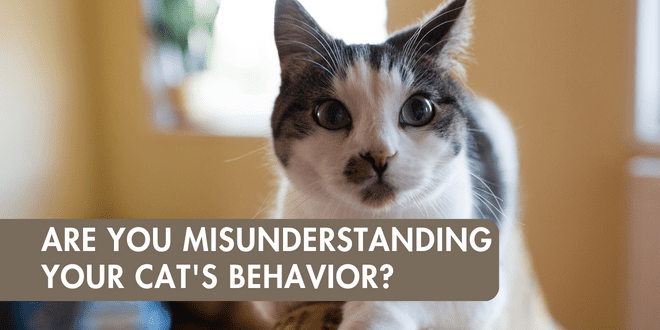
It still surprises so many people — even cat lovers themselves — don’t think that cats are trainable and behavior problems can often be resolved. Where we fail in tackling behavior problems is we assume the cat’s motivation is spite, anger, or stupidity. I promise you, your cat isn’t off in a corner plotting to do something just to watch you blow your top. What humans label as a misbehavior is actually a natural behavior that makes sense to the cat. It may be a normal behavior needed by the cat, or the way the cat is trying to solve a problem.
A Cat’s Misbehavior or Misunderstood Behavior?
Every behavior a cat displays serves a function or it wouldn’t be repeated. Animals aren’t stupid. The key to a successful behavior plan is to figure out what the underlying reason is for the repeated behavior and what the cat gets from displaying that particular behavior . That’s the information needed to change the conditions. To change the outcome you have to change the set-up. The first step in that direction is to stop labeling the cat a particular way. Saying your cat is aggressive, mean, or spiteful doesn’t help you solve the problem. A cat shouldn’t be identified and labeled by a behavior. A cat displays a particular behavior under certain circumstances.
Effective, positive, reward-based training gives the cat an alternative behavior of the same or increased value than the unwanted behavior. The right kind of training sets the cat up to succeed because it provides the things the cat wants and needs and allows for choice. The animal who doesn’t have any choices is the animal who starts reacting out of fear.
Think Like a Cat
Think like a cat and you’ll realize the unwanted behaviors your cat displays are not abnormal or bad. You may not like the displayed behavior but your cat isn’t acting crazy or spiteful. He’s trying to solve a problem according to what his instincts tell him. If he’s scratching the furniture he isn’t intentionally shredding your favorite chair just to be destructive. He has a natural need to scratch and will seek out the most effective object for that function. If the scratching post doesn’t meet his needs (it might be too wobbly, too short, or covered in the wrong kind of texture) then his intelligent brain will direct him to an object that will work more effectively. Scratching is important to the cat. Provide him with a scratching post that meets his needs better than your sofa or chairs and he’ll naturally prefer that. It really does make a difference when you take the time to look at your cat’s environment from his point of view. For more than four decades, my instruction to clients has always started with advising them to look at the environment from the cat’s point of view. It’s something that hasn’t changed and I still do it in every consultation to this day. It can be surprisingly eye-opening.
Four Important Steps for Correcting Your Cat’s Unwanted Behavior
Many cats are relinquished to shelters, banished to live outdoors, abandoned, or even euthanized for behavior problems that are misunderstood and are correctable. We get caught up in wrong assumptions regarding a cat’s motivation. Many times cat parents are given inaccurate information from people who aren’t qualified to give advice. Much of it comes down to common sense. Look at what your cat is doing and the circumstances surrounding the behavior.
-
- What behavior is the cat displaying?
- What are the circumstances?
- What is the cat getting out of the particular behavior?
- How can you change the outcome or provide a better alternative?
When you start looking at the conditions surrounding a behavior it sets you up to then be able to identify possible causes of that behavior. When you identify possible predictors/triggers, you can change the conditions. If the cat bites you every time you pick him up, for example, instead of labeling the cat as mean and punishing him for biting, you can now look at the technique you’ve been using. Has your approach triggered a negative response? Did your approach startle your cat? Did you misread the cat’s body language that was saying he didn’t want interaction? To create a better outcome, you need to create a better set-up so the cat learns to feel more comfortable and feels as if he has choice.
Why Punishment Doesn’t Work With Your Cat
Many people reprimand the cat for misbehaving. Instead of focusing on what the cat needs and how to help him succeed, these cat parents, out of frustration, choose punishment. Imagine the stress the cat endures when he’s punished for a behavior that’s actually normal and needed in his daily life. Punishment is all about releasing our own frustration and does nothing to teach the cat anything other than to be afraid and defensive.
Let’s examine litter box problems for example. The cat stops using the litter box and starts urinating on the carpet in the dining room. The cat parent who punishes, rubs the cat’s nose in the mess, hits, yells, sends the cat into time-out, or forces the cat into the litter box has only succeeded in doing one thing: elevating the cat’s fear and stress to an emotionally and physically unhealthy level. What if the cat was eliminating outside of the box because he was in pain due to a urinary tract problem and associated the box with his pain? Because he will now associate punishment with the need to eliminate, he is not only in pain from the medical condition but he’s afraid and unsure about where to pee or poop. As a cat parent you intended to convey the message that the cat’s location choice for elimination was wrong but the actual message he received was that urination is bad and will result in punishment and fear. Since urination will have to occur again at some point when his bladder gets full, he’ll become stressed and may attempt to retain urine as long as possible and that’s not physically healthy. He may also attempt to find a more secretive place for elimination to avoid your punishment. Either option causes even more stress to an already stressed-out cat.
Cats aren’t Dogs or Fur-Covered Children
Many behavior problems could also be corrected or avoided in the first place if people stopped viewing their cats as children or dog substitutes. Cats should be loved and cherished but when you forget that he is a CAT with specific, normal feline needs and the inability to scheme, it’s a set-up for failure. Additionally, when you adopt a cat and expect him to act like a dog and then are disappointed because he doesn’t interact with you the way dogs do, it creates another lose-lose situation. View cats as the beautiful, intelligent, playful, social creatures that they are and you might just be surprised what you’ll learn. You have an opportunity for an amazing relationship with the cat in your life if you take the time to look at his world the way he does and what he needs to thrive physically, mentally, and emotionally.
Need More Information?
For more specific information on the correct behavior techniques to use for behavior problems, refer to the best-selling books by Pam Johnson-Bennett. Pam’s books are available at bookstores and online. We’ve included Amazon links here on our website.
If you have a question regarding your cat’s behavior or health, contact your veterinarian. This article is not intended as a replacement for your cat’s veterinary care. This article is for information purposes only and not offering medical advice or providing a medical diagnosis.





